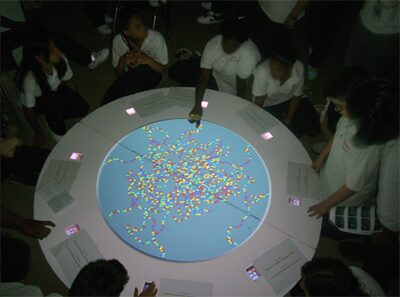Introducing nanoscale phenomena to middle school learners using a DNA design activity
Introducing nanoscale phenomena to middle school learners using a DNA design activity
Lopez Silva, B., Bernasconi, M., Abuhabsah, A., Moher, T.
- Location: San Diego, CA
- PDF: aera2009dnaunit-published.pdf
- Caption: Students use PDAs surrounding dynamic simulated “cauldron” to design and attach candidate “catcher” strands
- Credit: B. Lopez Silva, LTG
This paper summarizes the design rationale and classroom experience surrounding a middle school instructional unit on a nanoscale phenomenon: the self-assembly of DNA strands as applied to the problem of virus detection. The instructional design was motivated by a strategy for integrating new nanoscale content into an existing curricular unit, situating learner activity within a design framework, and using multiple representations of nanoscale phenomena, both as media for the design activities and as the object of student critique. Students in a middle school classroom showed significant pre-post gains both in their understandings of domain concepts and in their ability to articulate affordances and constraints of representations and models.
